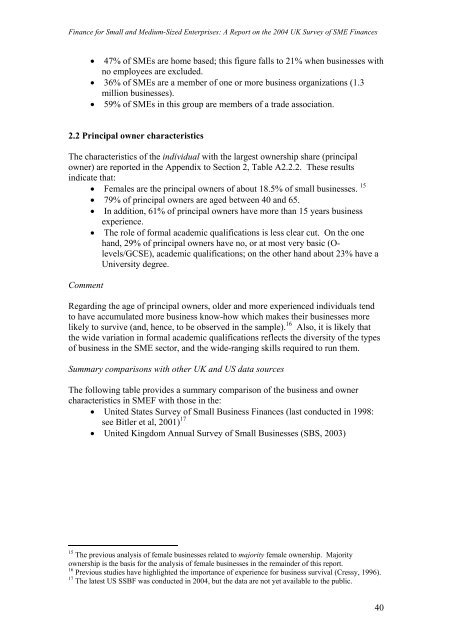Finance for Small and Medium-Sized Enterprises - DTI Home Page
Finance for Small and Medium-Sized Enterprises - DTI Home Page
Finance for Small and Medium-Sized Enterprises - DTI Home Page
Create successful ePaper yourself
Turn your PDF publications into a flip-book with our unique Google optimized e-Paper software.
<strong>Finance</strong> <strong>for</strong> <strong>Small</strong> <strong>and</strong> <strong>Medium</strong>-<strong>Sized</strong> <strong>Enterprises</strong>: A Report on the 2004 UK Survey of SME <strong>Finance</strong>s<br />
• 47% of SMEs are home based; this figure falls to 21% when businesses with<br />
no employees are excluded.<br />
• 36% of SMEs are a member of one or more business organizations (1.3<br />
million businesses).<br />
• 59% of SMEs<br />
in this group are members of a trade association.<br />
2.2<br />
Principal owner characteristics<br />
he characteristics of the individual with the largest ownership share (principal<br />
wner) are reported in the Appendix to Section 2, Table A2.2.2. These results<br />
dicate that:<br />
• Females are the principal owners of about 18.5% of small businesses. 15<br />
T<br />
o<br />
in<br />
• 79% of principal owners are aged between 40 <strong>and</strong> 65.<br />
• In addition, 61% of principal owners have more than 15 years business<br />
experience.<br />
• The role of <strong>for</strong>mal academic qualifications is less clear cut. On the one<br />
h<strong>and</strong>, 29% of principal owners have no, or at most very basic (Olevels/GCSE),<br />
academic qualifications; on the other h<strong>and</strong> about 23% have a<br />
University degree.<br />
Comment<br />
ore<br />
likely to survive (<strong>and</strong>, hence, to be observed in the sample). 16 Regarding the age of principal owners, older <strong>and</strong> more experienced individuals tend<br />
to have accumulated more business know-how which makes their businesses m<br />
Also, it is likely that<br />
the wide variation in <strong>for</strong>mal academic qualifications reflects the diversity of the types<br />
of<br />
business in the SME sector, <strong>and</strong> the wide-ranging skills required to run them.<br />
Summary<br />
comparisons with other UK <strong>and</strong> US data sources<br />
he following table provides a summary comparison of the business <strong>and</strong> owner<br />
haracteristics in SMEF with those in the:<br />
• United States Survey of <strong>Small</strong> Business <strong>Finance</strong>s (last conducted in 1998:<br />
see Bitler et al, 2001) 17<br />
T<br />
c<br />
• United Kingdom Annual Survey of <strong>Small</strong> Businesses (SBS, 2003)<br />
15<br />
The previous analysis of female businesses related to majority female ownership.<br />
Majority<br />
ownership<br />
is<br />
the basis <strong>for</strong> the analysis of female businesses in the remainder of this report.<br />
16<br />
Previous studies have highlighted the importance of experience <strong>for</strong> business survival (Cressy, 1996).<br />
17<br />
The latest US SSBF was conducted in 2004, but the data are not yet available to the public.<br />
40















![Joint Report on Social Protection and Social Inclusion [2005]](https://img.yumpu.com/19580638/1/190x132/joint-report-on-social-protection-and-social-inclusion-2005.jpg?quality=85)
